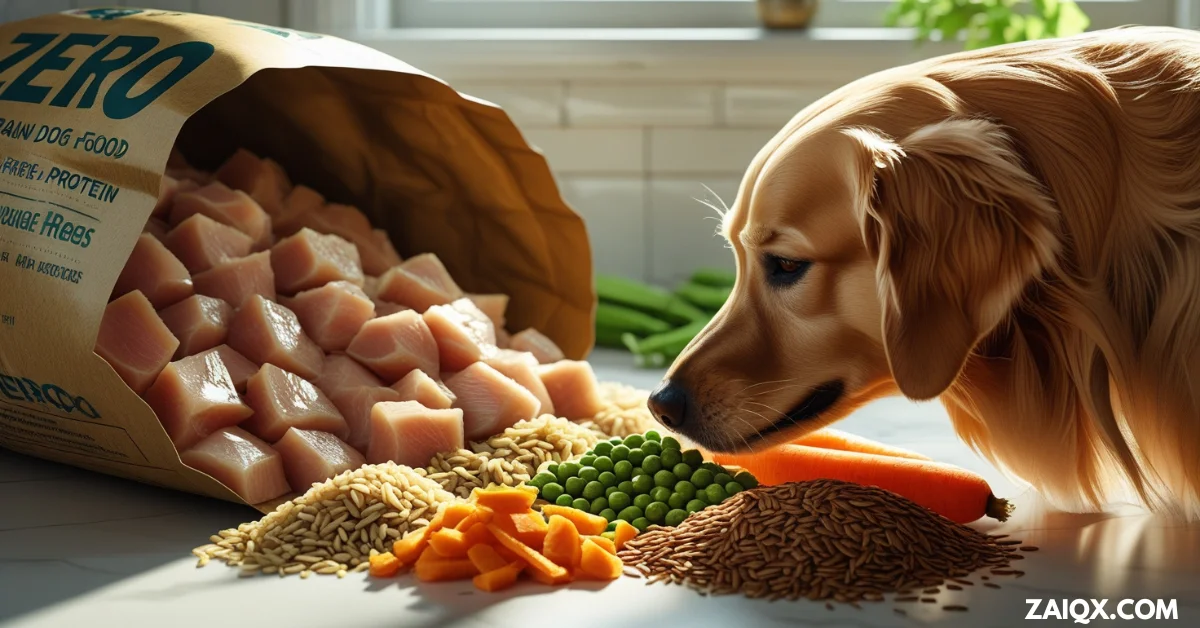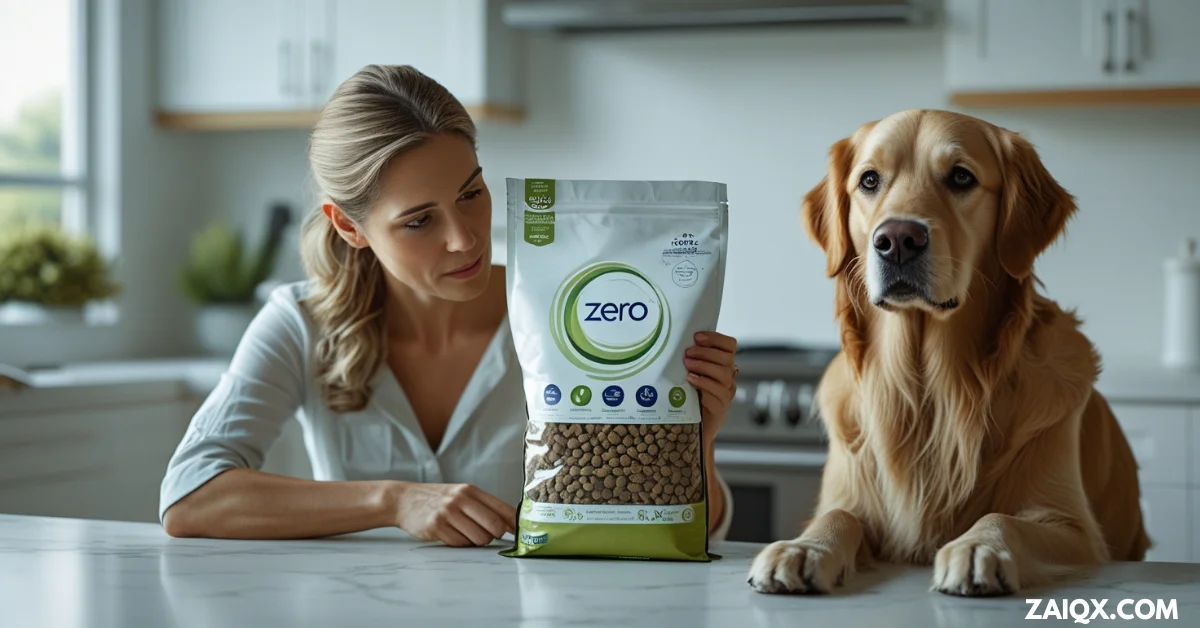Introduction
Choosing the right food for your dog is one of the most important decisions you’ll ever make as a pet parent. We all want our furry friends to live long, healthy, and happy lives — and a big part of that depends on what goes into their bowls.
One brand that’s been getting a lot of attention lately is Zero Dog Food. With promises like “grain-free,” “high protein,” and “ideal for sensitive dogs,” many owners are switching to it hoping for better results. But is it really as healthy as it sounds?
In this detailed article, we’ll explore the real truth behind Zero Dog Food — including ingredients, pros, cons, expert opinions, and what actual dog owners are saying. If you truly care about your dog’s health, this is a must-read before your next purchase.
What Is Zero Dog Food?
Zero Dog Food is a grain-free, premium pet food brand that targets dog owners looking for clean and simple nutrition. It claims to be free of unnecessary fillers and artificial additives, focusing instead on natural ingredients like meat, sweet potatoes, and flaxseed.
Key Claims by the Brand:
- Grain-free for better digestion
- High-quality animal protein sources
- Suitable for dogs with allergies
- No artificial preservatives or colors
- Supports skin, coat, and joint health
On the surface, these claims sound great. But as we’ll see, marketing doesn’t always equal quality.
Why Are Pet Owners Choosing Zero Dog Food?
Pet owners are increasingly becoming conscious of what goes into their pets’ food. Zero Dog Food appeals to those who want to avoid:
- Cheap fillers like corn and soy
- By-products and unnamed meat meals
- Artificial colors and flavors
- Preservatives like BHA and BHT
The brand positions itself as a healthy alternative to traditional kibble. It’s also priced higher than most supermarket brands, which gives the impression of being premium and trustworthy. But is this reputation truly earned?
Ingredients in Zero Dog Food: A Closer Look
Let’s break down the typical ingredients found in Zero Dog Food – Chicken & Sweet Potato Recipe:
✅ Good Ingredients:
- Deboned Chicken – A solid source of real protein.
- Chicken Meal – Concentrated protein from chicken.
- Sweet Potatoes – Easily digestible, high in fiber and nutrients.
- Chicken Fat – Offers essential fatty acids for skin and coat.
- Flaxseed – Source of omega-3 fatty acids for joint and heart health.

❌ Questionable Ingredients:
- Peas and Chickpeas – These legumes are used as fillers and can affect amino acid balance.
- Natural Flavor – Vague and not regulated; could be animal digest or flavor additives.
- Tapioca Starch – Often used as a thickener but adds unnecessary carbs.
🚨 Ingredient Red Flag:
Too many grain-free foods — including Zero Dog Food — rely heavily on peas, chickpeas, and lentils. Recent studies show these ingredients may be linked to heart issues in dogs, specifically Dilated Cardiomyopathy (DCM).
The Shocking Truth: What the Label Doesn’t Say
Many pet owners choose Zero Dog Food based on marketing, but few know the full story. Here are the biggest concerns experts and vets have:
1. Grain-Free = Not Always Better
Grain-free foods are often seen as a healthier choice, but most dogs aren’t actually allergic to grains. In fact, whole grains like brown rice or barley offer important nutrients and fiber.
More importantly, grain-free diets using legumes (peas, lentils) as main ingredients have been linked to a rising number of heart problems in dogs, according to the FDA.
2. No Feeding Trials
Zero Dog Food hasn’t undergone AAFCO-approved feeding trials, which are tests that determine whether the food supports long-term health. Without these, there’s no guarantee that your dog is getting complete and balanced nutrition.
3. No Veterinary Backing
Most veterinary nutritionists do not recommend boutique grain-free brands unless backed by clinical data. Zero Dog Food lacks this support.
Real Reviews: What Dog Owners Are Saying
We searched real customer reviews on pet food forums, retailer sites, and dog owner groups to find out what actual users think. Here’s a summary of the most common feedback.
⭐ Positive Reviews:
- “My dog loves the flavor and has no more itchy skin!”
- “Helped with digestive problems — firmer stool and less gas.”
- “I like that it doesn’t contain any unnecessary junk.”
❗ Negative Reviews:
- “My dog got diarrhea within a week of switching to Zero.”
- “Too expensive and made no difference in my dog’s health.”
- “Stopped eating it after a few days — something’s off.”
Common Complaints:
- Digestive issues (vomiting, diarrhea, gas)
- Refusal to eat the kibble
- High price tag with inconsistent results
Pros and Cons of Zero Dog Food
Let’s break it down simply.
✅ Pros:
- High-quality proteins (real meat as first ingredient)
- Grain-free for dogs with known grain allergies
- Free from artificial preservatives and flavors
- Contains flaxseed for omega-3 benefits
- Appeals to picky eaters
❌ Cons:
- Over-reliance on legumes (peas, chickpeas)
- No feeding trials or veterinary endorsement
- May cause digestive issues in sensitive dogs
- Higher risk of DCM in grain-free diets
- Expensive compared to more proven brands
Is Zero Dog Food AAFCO Approved?
Zero Dog Food meets the basic nutrient profiles set by AAFCO (Association of American Feed Control Officials), but it has not gone through AAFCO feeding trials.
This means it meets the minimum nutrient levels but hasn’t been tested on real dogs for real-world results.
Is Zero Dog Food Safe for Puppies?
Zero Dog Food offers a puppy formula, but due to the concerns around grain-free diets and unproven recipes, many vets recommend choosing brands with clinical support for growing puppies.
Puppies need precise levels of calcium, protein, and phosphorus — which are harder to balance in boutique diets.
Healthier Alternatives to Zero Dog Food
If you’re concerned about Zero Dog Food but still want a high-quality option, here are some trusted alternatives:
🔹 Budget-Friendly & Vet-Approved:
- Purina Pro Plan
- Hill’s Science Diet
- Royal Canin
These may not have fancy packaging, but they are tested, balanced, and trusted by vets.
🔹 Premium & Transparent:
- The Farmer’s Dog (Fresh food subscription)
- Ollie
- Open Farm
- Spot & Tango
These offer fresher ingredients and better transparency without the risks linked to grain-free kibble.
Final Verdict: Should You Trust Zero Dog Food?
Zero Dog Food sounds amazing on the surface. It uses real meat, avoids grains, and skips artificial ingredients. But the lack of feeding trials, overuse of legumes, and growing concerns about grain-free diets should make pet owners think twice.
Some dogs may do well on it. But others might experience health problems that are hard to trace back to food until it’s too late. When it comes to your dog’s long-term health, science-backed food is always a safer choice.
Conclusion
It’s easy to fall for attractive packaging and big promises, but your dog’s nutrition needs more than just buzzwords. This Zero Dog Food review reveals a shocking truth: many “healthy” sounding options aren’t backed by real science or safety testing.
Always ask your vet, read ingredient labels carefully, and choose food that puts your dog’s health above trends.
FAQS
Is Zero Dog Food good for sensitive dogs?
It may help some, but others experience digestive issues. Always monitor closely.
Why is Zero Dog Food grain-free?
To appeal to pet owners who believe grain-free is healthier — though that’s not always true.
Can Zero Dog Food cause heart issues?
Possibly. Grain-free foods rich in legumes are under investigation for DCM risks.
Is Zero Dog Food safe for senior dogs?
Senior dogs need joint, heart, and kidney support. Zero Dog Food may not offer all that — consult your vet first.
How should I switch away from Zero Dog Food?
Gradually mix the new food over 7–10 days to avoid upsetting your dog’s stomach.

